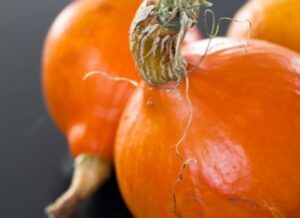What Do You Get When You Mix a Chestnut and a Pumpkin? Red Kuri Squash

I’ve always been a big pumpkin fan, but I’m an even bigger sweet potato fan. I love the sweetness of sweet potatoes, but even more, I love their texture: dense, compact, creamy. Of course, pumpkin always felt a little bit more guilt-free: lower in calories and easier to buy local here in France, where sweet potato is seen as “exotic.” And so, even though I love sweet potatoes, I kept buying locally grown pumpkin, applauding my efforts to stay local and support local farmers. And then I met my match: red kuri squash. Suddenly, all bets were off.
What Is It?
Red kuri squash, also known as hokkaido squash, was like nothing I had ever tasted before. Its texture is somewhere between the creamy and solid, with a pumpkiny flavor that has a hint of something else. Often, it’s compared to chestnut, which is where the French word comes from: potimarron — a portemanteau of potiron — pumpkinand marron — chestnut.
What To Do With It?
Intrigued, I decided to learn more. The best way to do this is, of course, to go to the source: the farmer. I bought my first red kuri squash at the farmer’s market, where it was sitting between a giant pumpkin being cut and sold into wedges and a too-perfect butternut squash. I pointed to it and asked about it, and the farmer passed it to me jovially, letting me in on the best thing of all: unlike other winter squash, red kuri squash — when organic and young — doesn’t need to be peeled.
I started by cooking it the way I like my sweet potato: roasted. I tossed the cubes with oil and salt and roasted them in the oven at 450 degrees, tossing once or twice. After half an hour, the cubes were golden brown and delicious. The interior is melt-in-your-mouth creamy, the edges are golden and crispy, and you hardly notice the skin. I suppose you could peel it for aesthetic reasons, but since I know that my farmer uses only natural pesticides, I feel fine eating the skin. The seeds can be roasted like regular pumpkin seeds, and the flesh can be used like that of any winter squash, lending a sweet creaminess that is particularly perfect in risottos or in soups, like this pumpkin-coconut soup. Some highlight the sweet nature of it and use it in red kuri pie, similar to pumpkin pie. I use it in my recipe for pumpkin butter.
Where to Find It?
Here in France, red kuri squash is very easy to find. In fact, it’s easier to find than sweet potatoes, my old standby! In the States, however, it’s a bit tougher to uncover. Some people grow their own, as they are very easy to grow. You can purchase organic red kuri seeds online. Some farmers markets are starting to stock them as well, and every once in awhile, you’ll find them in Asian markets.
Image: Pauline Mak

